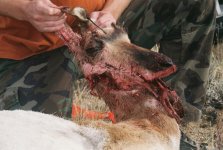The real reason I am torn when this comes up.... I like to recover the bullets to see what kind of performance was achieved.
I like to recover bullets too, when it's possible. That said, I've only recovered three in all my years of hunting (I've been hunting all my life).
One was from a little coues deer buck that was shot at around 80 yards. The bullet was a 175 gr 7mm Sierra Game King, and it didn't exit even though it never hit any bones. The jacket I recovered has no lead in it, and even though the deer dropped on the spot, I consider it bullet failure. Those bullets were loaded for elk, and that bullet likely would NOT have performed well on a larger animal; especially if bone was hit.
Another was revovered from an elk shot at around 600 yards (finishing shot), a 145 gr 7mm Speer BTSP. It mushroomed just like I'd want, and the elk dropped when the bullet hit.
The 3rd is a .22 LR bullet (Velocitor) recovered from the far side of a bobcat's head after it passed through the skull and brain. The entrance was up the nose, and the bullet was just under the skin on the backside of the head.
But, when the bullet passes out the backside, and the animal drops in it's tracks, I don't need the bullet to show what performance I got. If I need more, I can usually tell what happened from the level of meat damage.

Daryl

